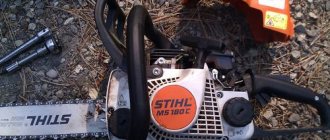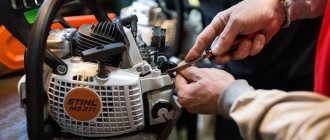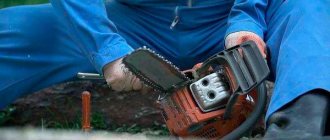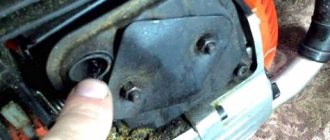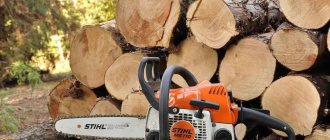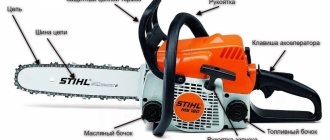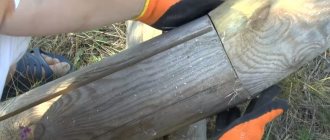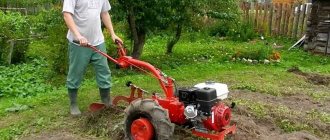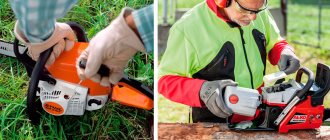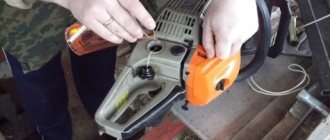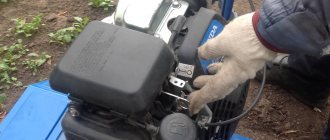Chainsaw carburetor design
Almost all carburetors used in the production of chainsaws have the same design. The only difference is the mechanisms with which Chinese garden tools are equipped.
As standard, the fuel unit consists of the following parts:
- float chamber - this element is designed to continuously maintain the required amount of fuel. When the unit is operating, fuel is transferred through a built-in nozzle to the atomizer;
- tube - through it, fuel enters in portions into the chamber. The fuel supply is regulated by the position of the built-in factory damper;
- atomizer - this part is necessary for injecting fuel into the intake air flow.
The operating principle of a chainsaw carburetor is quite simple. During operation of the unit, air is sucked into the tube and passes through it at a speed that is regulated by the built-in damper. When the damper opens, the float located in the chamber is activated. After passing through the diffuser, the air is mixed with fuel and instantly atomized. Next, the high-quality fuel mixture enriched with air passes through the intake channel and enters the engine cylinder. The diagram will clearly tell you about the operation of the carburetor.
The fuel circulates in the unit under pressure. In the float chamber it is close to atmospheric, but in the standard tube that sucks in the air, it is more rarefied. Due to the difference in the pressure generated, the fuel mixture enters the tube. The greater the amount of fuel, the higher the speed the engine of a household chainsaw can create.
How to flush a chainsaw carburetor?
You can clean the carburetor on a chainsaw using any aerosol cleaner. The brands Mannol, Hi-Gear and Nowax have proven themselves best. These compounds are good at cleaning the walls and parts of the carburetor from accumulated dust, carbon deposits and hardened resin.
Both Chinese and German carburetors are washed in the same sequence.
Cleaning the carburetor on a chainsaw is performed in the following order:
- First, you need to drain the used fuel remaining in the fuel tank. Next, you need to unscrew the mount and remove the protective cover of the chainsaw body, and also remove the standard air filter;
- Next, you need to remove the hose responsible for supplying fuel. To do this you will need to open the latches. After this, you need to unscrew the fasteners and remove the top cover of the factory assembly housing;
- Next you will need to remove the cover with the blue gasket, which plays the role of a fuel pump membrane. Near the body there are brackets in the form of springs. They will need to be removed and the screws removed;
- Then you need to unscrew the screw and carefully remove the needle valve. Directly below it is a built-in spring, which also needs to be removed. After this, you need to pull out the damper and the standard axle, carefully pulling them along towards you;
- After this, you will need to remove the drive arm, as well as the throttle body and its factory axle;
- All extracted parts of the chainsaw carburetor will need to be laid out on paper and their integrity checked. If necessary, worn parts must be replaced;
- Next, all dismantled parts must be washed with a spray can. The same must be done with the float chamber and carburetor body.
- After complete drying, all parts must be installed in the reverse order.
After washing, the carburetor will need to be installed in its regular place in the chainsaw. Next, you will need to start the garden tool and observe its operation at idle and maximum speed.
Adjusting the chainsaw carburetor
This procedure is necessary specifically in cases where a garden tool does not start or, after starting, immediately stalls. Adjusting the carburetor of a chainsaw is also necessary when its power has dropped or the amount of fuel consumed has noticeably increased.
For self-adjustment, each manufacturer includes adjusting screws in the package of their garden equipment. The bolt, marked H, is used to adjust the position of the main jet and the operation of the internal combustion engine at high speeds. Bolt L is necessary for basic adjustment of the position of the built-in idle speed jet generated by the motor. Accordingly, the T screw is required by the chainsaw owner to quickly adjust the idle speed of the factory engine. In some cases, this bolt is also marked with the letters S or LA.
Muffler problems
Some chainsaw breakdowns are associated with improper removal of gases that are produced when fuel is burned. An example is the appearance of a large amount of smoke at high speeds, as well as unstable operation. Due to the large amount of soot and mechanical damage, the throughput of the muffler is significantly reduced: Cleaning of soot is carried out as follows:
- Carry out dismantling, during which the outlet hole must be closed.
- The muffler can be disassembled and its internal condition checked. However, in some cases the design is non-removable.
- You can clean the internal space from carbon deposits using special substances. The dry method, which involves mechanical action, is less commonly used.
Cleaning a chainsaw from carbon deposits
After cleaning the structure, it must be thoroughly dried. You can speed up drying using a hair dryer. When reassembling, you need to open the outlet hole.
How to properly adjust the carburetor on a chainsaw?
Before setting up the carburetor on a chainsaw, you need to carefully prepare for the procedure. First of all, you need to find descriptions of the angles of rotation of the adjusting screws in the instruction manual. If you arbitrarily turn the bolts without following the manufacturer's instructions, this can lead to serious damage to the engine of the tool.
The motor itself must be in full working order. You should also thoroughly clean the air filter before tuning. Otherwise, it will not be able to pass air in the volume required to enrich the fuel mixture, which will lead to incorrect carburetor settings.
Adjustment of the unit must be performed on a flat surface. The saw itself should be installed so that its saw attachment is located away from the operator's feet and face. Immediately before tuning, you will need to remove the upper part of the protective plastic body of the tool, as well as remove the foam rubber and part of the standard air filter. To configure the unit, you will need a thin shaped screwdriver.
What to do if gasoline does not flow into the carburetor of the chainsaw?
The first reason for this failure is that the fuel filter is clogged with dust and dirt. This happens due to the presence of a large amount of harmful impurities in gasoline and the used motor oil. Over time, they accumulate on the surface of the filter, causing it to lose its ability to pass fuel. To solve the problem, you will need to thoroughly clean the filter by rinsing it in a bath of cleaning agent. If the filter develops holes or other signs of wear, it needs to be replaced immediately.
The second cause of failure is contamination or breakage of the tube through which fuel is supplied to the carburetor. If the hose is not torn, then cleaning it will be enough to thoroughly blow it with compressed air from an aerosol. If the tube is broken, it will need to be replaced. When installing the hose, the joints between it and the fittings must be carefully treated with sealant.
There is one more malfunction that occurs much less frequently than the previous two. It consists of a breakdown of the valve that regulates the rate of fuel supply to the carburetor. If dust or small chips get inside its mechanism, the damper is blocked and remains in the closed position. Repair of the unit can only be done by replacing the damper, since it most often cannot be restored.
Replacing crankshaft oil seals on a Chinese chainsaw. Replacing oil seals on a chainsaw: Shtil, Ural and others
Today, many users cannot do without a high-quality chainsaw, because in everyday tasks it helps to cope with various wood, branches and firewood. Thus, the tool must always be in good condition, for which timely diagnose and repair the required element.
Depending on the model used, parts and small seals may be of different quality. Replacing oil seals on the crankshaft and other elements is a responsible task, although it takes a minimum of time. Oil seals are made of high-strength rubber, but over time they leak and require timely replacement. When the oil seal cracks or becomes defective, oil begins to leak, which leads to breakdown of the entire engine. Therefore, when identifying the problem, quickly replace it with a similar part.
Each chainsaw, regardless of brand and price, has the same design, so more often the oil seal leaks in the crankshaft area. Also, oil seals are located in all rotating mechanisms of the saw; if possible, check them. If you have minimal knowledge of the design of a chainsaw, then getting to the oil seal will not be difficult. Simply remove all elements that interfere with access to the crankshaft oil seal.
Please note: there are 2 oil seals on the crankshaft, one at the beginning of the crankshaft, the other at the end. The part reliably seals the inside of the engine, covering the bearing. Without this oil seal, oil will spurt out in all directions, so the breakdown can be determined by oil leaks from the crankshaft side.
How to remove the crankshaft oil seal on a Stihl chainsaw?
Regardless of the brand of chainsaw or its design, the removal of oil seals is carried out using a similar technology. When you reach the broken part, carefully remove the seal. This is done in several ways:
- Using a special puller, but make sure that the oil does not come out of the crankcase;
- A cheaper and easier way is to pick out the oil seal from the groove with a sharp object;
- If the part fits tightly and its size is sufficient, you can use the old proven method - screw a self-tapping screw into the oil seal and pull it out with pliers.
It is not necessary to save the old oil seal during dismantling, but the main thing is not to damage other parts of the chainsaw. If we are talking about branded ones, then it is better to do the work in specialized services. It is also better to buy an original oil seal; practice shows that cheap analogues quickly begin to leak.
The new oil seal is put on quite simply; it needs to be pressed into the mounting hole with a puller or other object. The main thing is that it fits in smoothly and does not stick out. You also need to do everything carefully, since the rubber part is easily damaged. The dimensions of the chainsaw oil seals may be indicated in the old model, or they can be easily selected according to the model of your chainsaw. As you can see, replacement does not cause any difficulty; it is carried out similarly with other oil seals.
Why does a chainsaw shoot into the carburetor?
Often, chainsaw carburetor malfunctions are associated with loud extraneous sounds that come from the unit. Ignoring them will lead to even more serious damage, which will be much more difficult to eliminate.
First of all, you need to understand the causes of extraneous sounds. The first of them is an incorrectly set ignition, due to which the used fuel does not have time to burn in the internal combustion engine cylinder in time. This leads to the formation of a short-term shooting noise that is repeated with each cycle of fuel injection into the cylinder.
To fix the problem, you need to adjust the gap between the flywheel and the standard ignition coil of the chainsaw. To do this, you need to remove the left protective cover of the plastic case and clean the parts underneath. To the right of the ignition coil there are 2 screws, turning them counterclockwise will allow you to move the flywheel away from the standard coil. Next, you will need to attach a template to the side of the coil and begin to slowly turn the factory screws in the opposite direction. As soon as the built-in flywheel comes close to the previously installed template, you will need to stop turning the screws.
After adjusting the ignition gap, you need to check the operation of the chainsaw. If it still fires, then you need to inspect the spark plug. If carbon deposits have accumulated on it, the part must be cleaned and completely dried.
Another reason why the chainsaw you are using is firing is due to the incorrect proportion of the prepared fuel mixture. If there is too little gasoline or motor oil, the engine of the garden tool will not be able to operate stably. In this case, you will need to completely drain the fuel and prepare the mixture in accordance with the manufacturer's instructions.
In some cases, a disturbance in the supply of fuel to the engine cylinder may be caused by improper operation of the standard carburetor jets. In this case, you will need to adjust the carburetor and alternately check the operation of the tool at idle, low and high speeds.
Do-it-yourself chainsaw construction and tool repair
A chainsaw is a valuable tool in the household today. For many owners of country houses, this unit has become indispensable. Despite its fairly simple design, the tool sometimes fails. However, almost anyone with a certain amount of knowledge in the field of technology and a set of necessary tools can repair a chainsaw on their own.
Chainsaw device
The simple design of the tool allows you to repair the chainsaw yourself. The main elements of the unit are the following:
- Power point.
- Clutch.
- Oil pump.
- Chain transmission.
- Chain catchers and brake system.
Depending on the brand, some changes may be made to the design of a particular instrument. For example, the engine can be located horizontally or vertically. In professional saws, the second option is most often used. Thanks to the horizontal arrangement of the power plant, the dimensions of the tool are significantly reduced, which is important for home use. Knowing the structure of the unit, you can quickly understand how to disassemble a chainsaw.
The most common tool malfunctions
No matter how competently the unit is operated, problems occasionally arise in the operation of its systems. To fix them, you need to determine the cause. Knowing the design of a chainsaw, we can say that most often problems arise with the operation of the engine. However, do not forget about other components that are also subject to wear.
Problems with the power plant
It can take quite a lot of time to identify the cause of an engine malfunction. Among the main signs of failure, several main ones should be noted:
- The engine does not start.
- The power plant starts to work, but quickly stalls.
- Maximum power is not achieved at idle speed.
- There are interruptions in work.
When diagnosing a malfunction, it is necessary to use the method of exceptions. It is better to start checking with those reasons that will require a minimum of time to eliminate. Most often, a power plant malfunction is associated with the ignition system. It is the condition of the spark plug that can say a lot about the operation of the entire engine. First, using a special key, you need to remove this element and then check its external condition. The performance of the ignition system can be easily determined by sparking. When a strong and stable spark appears, you should proceed to inspect the fuel supply system.
The following problems are possible in its operation:
- A clogged breather cap prevents fuel flow.
- The fuel filter is dirty.
- Insufficient fuel is supplied from the carburetor to the cylinder.
To eliminate the malfunction, you should disassemble the system and clean it thoroughly. Problems with fuel supply can be caused by contamination of the corresponding filter, which interferes with the process of creating a high-quality fuel mixture. If the chainsaw stalls under load, you should inspect the muffler, in which a large amount of combustion products could have accumulated. The most difficult problem is the malfunction of the cylinder-piston group. This applies not only to the repair of Chinese chainsaws, but also to products from well-known brands. In such a situation, it is practically impossible to do without purchasing spare parts.
Lubrication system and chain brake
When using the tool, special attention should be paid to monitoring the operation of the chain lubrication system. Most often, problems arise due to clogging of the channels through which lubricant is supplied. If there is a slight oil leak, you can continue working with the chainsaw. Otherwise, it is necessary to take urgent measures to eliminate the malfunction.
The first step is to check the tightness of the connections between the fittings and the tubes. It is quite possible that these parts will need to be replaced, but everything can be done by simply replacing the sealant. Don't forget about the oil pump, which needs to be checked visually. It must be replaced if there are cracks in the housing. Problems with brake operation most often arise due to contamination of the brake band.
Recommendations for use
To increase the life of the tool, you must follow some rules. This primarily concerns the saw chain and guide bars. It is recommended to replace the chain every three hours and turn the guides 180 degrees. As a result, these elements will wear out evenly, which will extend the life of the entire tool.
During operation, it is important to constantly monitor the cleanliness of the chainsaw. When sawing wood, the unit quickly becomes clogged with sawdust, which must be removed in a timely manner. Contamination of the technological holes can cause problems with the operation of the fuel system. It is also important to change oil and other consumables on time.
How to extend the life of a carburetor?
To prevent the breakdown of a standard unit, the owner of a garden tool should adhere to a number of rules. These include:
- using a properly prepared fuel mixture - each time you mix gasoline and engine oil, you must strictly adhere to the proportions specified in the operating instructions;
- use for refueling gasoline of the brand specified by the manufacturer - for operating an engine running on AI-92 gasoline, AI-95 fuel is not suitable, and vice versa;
- regular washing - cleaning the unit from dust and dirt accumulated on the walls will make its daily work easier;
- tuning the unit immediately after detecting problems - there is no need to delay adjusting the carburetor, as this can lead to even more serious damage.
During operation of the chainsaw, you need to ensure that dust, sawdust and small debris do not seep under its body. Otherwise, they will quickly clog the carburetor and block its operation.
Causes and solutions
Undoubtedly, after reading this title, you continue to read this paragraph and this is not surprising.
The carburetor is one of the most important components of any modern chainsaw. Its main task is to mix the fuel mixture with air, as well as further supply the finished fuel into the cylinder of the gasoline engine. During operation of a chainsaw, its carburetor is constantly working, therefore, over time, this unit begins to need adjustment and flushing. Performing these procedures is quite simple if you are extremely careful and follow the correct procedure.
Read also: Localization of automotive production in Russia
No. 1. Chainsaw won't start
If difficulties arise with starting a chainsaw, many immediately blame the carburetor. In fact, there are several options and the cause of the malfunction can be any:
- Air and/or fuel filters are clogged. The problem can be solved by cleaning the filters.
- Lack of fuel in the tank. Yes, there is such a reason - some owners forget about such an insignificant detail as refueling a chainsaw and think that a couple of liters of gasoline will last for six months. In addition, fuel in the tank should not be stored for more than 14 days, because gasoline evaporates and the octane number is lost.
- Check the pipe from the fuel tank to the carburetor - it could be clogged or broken, so gasoline does not flow into the tank.
- There is no spark at the spark plug. Why there is no spark - there can be many reasons: there is no contact, the spark plug needs to be changed or it is flooded. Why the spark plug on a chainsaw fills is another question. But if this happens, you need to dry it and reinstall it, and then check for a spark. If there is heavy carbon deposits on the spark plug, it is recommended to replace it.
- Check the muffler for carbon deposits. If there is carbon deposits, thoroughly clean the muffler, but it is still recommended to take the chainsaw to a service center to have the cylinder and piston checked, because carbon deposits are a sure sign of improper operation of the elements of the cylinder-piston group.
- The carburetor is clogged. How to properly adjust a chainsaw so that the carburetor works well is discussed in a separate article.
If none of the above methods helped, then the reason is more serious - a breakdown of one of the connecting rod-piston group units. In this case, it is recommended to take the chainsaw to a service center.
Repairing the gas handle of a chainsaw. Disassembling and assembling a chainsaw with your own hands
The low level of technical equipment of many service departments and the high cost of their services forces many owners of faulty chainsaw equipment to repair their gadgets themselves. How to disassemble a chainsaw, replace faulty parts, and also correctly assemble a chainsaw with minimal time and money?
Self-disassembly of a chainsaw requires the availability of spare parts, appropriate tools and plumbing skills. It is possible that to dismantle individual parts you will need special pullers, the manufacture of which will take more time than the repair itself.
In a number of modern models of household and semi-professional chainsaws, special keys not included in the supplied kit are used to dismantle the drive sprocket of the saw chain.
Self-repair problems
The problem in many cases is complicated by the lack of comprehensive information on repair technology. According to foreign manufacturers, after the saw has exhausted its service life, it should be scrapped, so the maintainability of many budget-level models raises reasonable doubts.
Professional-grade chainsaws are more difficult to restore.
- The problem is compounded by the high cost of spare parts.
- It is possible that to restore the functionality of individual components and mechanisms, in particular, to configure fuel equipment, special equipment will be required.
Replacing expensive branded parts with affordable but short-lived Chinese analogues does not justify itself economically. Practice shows that these components produce a service life of 50-60% at best.
Fault detection algorithm
The cause of saw failure or deterioration in its performance may be:
- clogged fuel tank cap breather;
- air leakage from the carburetor due to the destruction of the gasket or loosening of the threaded fasteners;
- mechanical jamming of removable saw equipment and other minor defects.
Before you begin disassembly, you should make sure that more extensive repairs are necessary.
It will most likely not be possible to independently assemble a new chainsaw after repair with the original quality. The design of modern chainsaws often uses press fits of mating parts, which have minimal repairability.
Even partial disassembly of a chainsaw using improvised tools can lead to undesirable consequences. In most cases, to eliminate a malfunction, you can limit yourself to dismantling a separate unit or system.
This list includes:
- connecting rod and piston group;
- carburetor;
- clutch mechanism;
- saw chain drive sprocket.
Tips for dismantling various components and systems
In the scope of this article, only general recommendations can be given, since chainsaws from different manufacturers may have significant technical differences.
Before disassembling a faulty tool, it is necessary to dismantle the saw set, drain the fuel and oil from the filling containers, and clean hard-to-reach places of the chainsaw from surface contaminants.
Fuel supply system
Disassembling the carburetor requires special attention. This assembly consists of many small parts, so the removed parts in a given sequence are placed on a clean sheet of paper. After washing all components, the carburetor is assembled in the reverse order.
Compression recovery
Less complex repair of the piston group. To dismantle the cylinder, it is enough to remove the threaded fasteners and lay the saw on its side to prevent pieces of a damaged compression ring, piston skirt or other foreign objects from getting into the engine crankcase.
The cylinder bore wears unevenly, so installing a new piston does not have a significant effect. As a rule, during a major overhaul, after checking the suitability of the crankshaft, a complete set consisting of a cylinder, piston, compression ring and piston pin is installed.
Starter repair
Disassembling the starter to replace the cord does not create problems for an experienced user, but the plastic case in most cases cannot be repaired. Most are copies of the most popular European models, so we disassemble the Chinese chainsaw according to the standard procedure.
Worn parts of the saw set cannot be restored.
- At home, you can shorten a new chain to fit a shorter bar.
- The service life of branded tire components is equal to the service life of three saw chains.
- This indicator can be significantly reduced by incorrect choice of chain pitch or excessive wear of the drive sprocket crown.
Finishing work
In a number of models, engine control elements, start blocking and an emergency stop system are located on the handles, where the operator’s hand is grasped. It is recommended to assemble the chainsaw handle after preliminary cleaning of the contacts of all electrical and mechanical communications.
Self-assembly of a chainsaw is part of the repair work that requires special attention. The success of the final result is facilitated by the correct sequence of operations, sufficiently high quality of parts, gaskets and other consumables.
No. 2. The engine stalls
The engine starts, but the chainsaw stalls at idle or under load. In this case, most often you should perform the same actions as described above.
How to adjust a chainsaw depends on exactly when the problems start:
Stalls immediately after starting:
- The fuel mixture is not prepared correctly, there is too much oil in it, so the octane number of gasoline is less than it should be, so the chainsaw only runs on choke or stalls immediately.
- Carbon deposits on the spark plug or improper gap between the spark plug and the wire.
It stalls and does not work at idle:
- The muffler is clogged. It is necessary to remove carbon deposits.
- The carburetor settings are off. The idle speed on the chainsaw needs to be adjusted. This is done using adjusting bolts marked L and H. For how to adjust idle speed, see the article about adjusting the carburetor.
Stalls at maximum speed and only runs on choke
- The air or fuel filter is clogged. The seals need to be cleaned and checked.
- The breather is clogged and because of this, fuel does not flow and pumping gasoline on the chainsaw does not work. Take the needle and carefully clean the breather.
- Fuel pump malfunction. Remove the pump and check to see if gasoline is leaking from it. If it oozes, replace the sealing gasket or the pump itself.
The chainsaw does not cut under load and stalls
- The air filter is clogged. It is necessary to take out the filter, clean it well or even rinse it, dry it and install it back.
- Wrong proportion of oil/gasoline mixture. Drain the fuel and remix the oil and gasoline in the correct proportions.
Engine breakdowns
Why does a chainsaw smoke is a fairly common question and problem. To create the force that is transmitted to the chain, a specific internal combustion engine is installed. During normal engine operation, the amount of smoke is minimal, the chain runs smoothly, and fuel consumption is within normal limits. Signs of engine trouble are as follows:
- There are many problems with starting.
- The engine overheats during operation.
- At idle or under load it stalls.
- A sharp, uncausal drop in power.
- Smokes a lot.
- Instability during operation, an unreasonable drop or increase in speed.
Chainsaw engine
The chainsaw does not cut well due to insufficient power. In addition, strong smoke or extraneous sounds may indicate severe wear of the internal structure. Most of the above signs indicate a serious malfunction, which is difficult to solve on your own.
No. 3. The engine "shoots"
If during operation there are extraneous sounds similar to gunshots, then there is a problem with the muffler or carburetor. How to make a chainsaw run quietly? It depends on which node is faulty.
Shoots the carburetor:
- Ignition is too late - the air-fuel mixture does not have time to burn out in the cylinder, so the sound is similar to a small explosion.
- Lean air-fuel mixture. Too little gasoline enters the mixture - the chainsaw, or rather the jets, needs to be adjusted to increase the fuel supply. Why the chainsaw revs on its own is for the same reason.
Shoots at the silencer:
- Enriched air-fuel mixture. Why does a chainsaw “shoot”? There is too much gasoline and not enough air in the mixture, so the mixture does not completely burn out in the chamber and partially burns out in the muffler. Carbon deposits on the exhaust are a clear sign of this. The air filter needs to be cleaned or the carburetor adjusted.
Ignition system malfunctions
If the symptom is a poor engine start, then there is a possibility that the problem is an incorrect setting of the fuel ignition system. The following cases are common:
- A chainsaw shoots into the carburetor.
- The chainsaw shoots into the muffler.
There are cases when kickback appears when starting a chainsaw.
Consumables can be called candles. They can often fail, and also indicate some other reasons for the malfunction of the device. The main features include:
- If fuel does not enter the carburetor, the surface is dry. The problem may be the filter or deformation of the supply pipes.
- Flooded with fuel indicates improper carburetor operation or adjustment.
- If the surface becomes covered with soot, then the problem lies in the use of low-quality oil, as well as improper mixing of fuel and carburetor settings.
Electronic ignition on a chainsaw
During long-term use, the spark plug itself may fail; it is enough to replace it with a new one.
No. 4. Chainsaw overheating
Why does the chainsaw get hot? The engine or tire may overheat - in any case, the fault is due to a small amount of lubricant.
- Engine overheating. The proportion of the fuel mixture is incorrect or pure gasoline is poured. Drain the fuel and make a mixture using the correct proportions of oil and gasoline, as specified by the manufacturer.
- Tire overheating. The oil pump needs to be cleaned or adjusted because... No oil is supplied to the tire.
No. 6. The chainsaw cuts to the side
When cutting, you may notice that the result is an uneven cut. Why does a chainsaw cut crookedly? There are several reasons:
- Incorrect chain sharpening. The teeth are sharpened at the wrong angle or only in one direction. Proper sharpening is required.
- Incorrectly selected chain. At very high speeds, a difference of even 0.2-0.3 mm between the width of the groove or the width of the seat will be visible, which is why the chainsaw cuts to the side. An appropriate circuit must be installed.
- Uneven tire wear. Over time, the tire wears out on one side and then the chain pulls to the side. Rotate the tire regularly to ensure even wear on both sides. If the wear is excessive, replace the tire.
No. 7. Chain lubrication problems
For normal operation, the chain must be constantly lubricated to reduce friction between the bar and the links, and also to prevent premature wear of the links.
- If the chain on the chainsaw is not lubricated, then there is a problem with the oil pump - oil is not supplied due to a clogged channel. Lack of lubrication is the reason why the chain stretches or why the chain breaks. Clean the channels; tiny particles of chips constantly get there and clog them. The oil hose may also break. If you need to adjust the chainsaw oil pump or repair it, it is better to contact a service center.
- Oil splashes from the chain. Incorrectly selected lubricant - it is too liquid, so it does not so much lubricate the links as it splashes onto the wood. Replace the lubricant with a thicker one.
Malfunctions of the chain lubrication system
In order for the device to work for a long time, as well as to simplify the sawing process, chainsaws have a special lubrication system. It runs on an oil pump, which can fail from time to time. The lubrication system can be checked as follows:
- Special oil is poured.
- The chainsaw is placed near a vertical surface.
- The saw turns on and the speed increases slightly.
Proper chain lubrication allows for a slight spread of lubricant.
No. 8. The chain falls off
Why does the chain fall off the tire? There may be several reasons and they are all different:
- Worn drive or driven sprocket. Due to the fact that the sprocket is worn out, the grip on the chain decreases, which is why the chain flies off the chainsaw. The sprocket needs to be replaced.
- The chain has stretched. Why the chain on a chainsaw stretches is due to insufficient lubrication. The metal heats up and stretches, even by a fraction of a millimeter, but if you take into account the number of links, then even 3-4 mm is enough for the chain to fly off the bar. The chain needs to be replaced.
- The chain tensioner that regulates its tension has become loose. how to regulate a chainsaw, or rather the chain tension? You need to adjust the tensioner - this can be done in just a few minutes.
No. 9. The chain does not rotate
Why doesn't the chainsaw chain rotate when the engine is running even at full speed?
- Leading sprocket. Either it is jammed, or the crown is worn out so much that it does not engage and the chain does not spin on the chainsaw. In any case, it is necessary to disassemble the sprocket to find out the exact reason why the chain does not spin. If the crown is worn out, it is necessary to replace the sprocket (or the crown itself, if the sprocket has a prefabricated structure).
- The chain brake is stuck. As a result, the sprocket is blocked by the brake mechanism, while the motor runs. It is necessary to turn off the engine and release the brake. If this happens under load, the brake mechanism will have to be changed, as well as the sprocket, because Due to the high temperature, many elements can melt and overheat.
No. 10. Chain brake does not work
All chainsaws are equipped with a main and inertial (emergency) brake. The latter turns on only when a backfire occurs. The main brake is designed to stop the chain while the engine is running. Why does the chain on the chainsaw jam and it doesn’t stop? Option two:
- The brake band is badly worn and does not provide sufficient stopping effect. The brake band needs to be replaced.
- Contamination of the tape. When working, debris may become clogged in the under-cover space: shavings, sawdust, dirt, etc. Debris is blocking the brake mechanism, so if the brake does not work, you need to clean the brake mechanism.
Home page » Chainsaw Shoots Carburetor
Related Posts
The chainsaw does not start: causes and solutions
Today, it is probably difficult to find an owner who does not have such a universal, practical, and multifunctional tool as a chainsaw.
This device is deeply rooted in everyday life, and this is not surprising because the chainsaw has become an indispensable assistant for us in the field of cutting wood of various types, preparing firewood for the winter, cutting down trees, and it is also used in the construction industry, etc.
Naturally, one can talk endlessly about its positive aspects and it copes with its task simply superbly . But, like any technology, no matter how unique and highly practical it is, it breaks down over time and that’s normal. Why does the Ural chainsaw shoot into the carburetor? Cause of malfunction, consequences. Why does a chainsaw shoot into the muffler? The most important thing at this moment is to correctly determine the cause of the malfunction and quickly eliminate it.
Naturally, you can turn to various kinds of services that, for a fee, will put your equipment in order. But you will have to pay a significant cost. What for? After all, you can try to determine the extent and cause of the breakdown yourself and fix it.
Since there are such minor breakdowns that can be repaired within five minutes. We will talk about them and ways to eliminate them in this article.
Plant structure
The first and practically main element of a chainsaw is the engine, namely a two-stroke carburetor (see carburetor adjustment). Its direct power can be varied, it all depends on the model of the device and its intended purpose. Chainsaw set The second no less important part of the tool is the set (saw) which consists of a chain (cutting), bar, sprocket, wheel (chain) . It is worth adding to this that completely different manufacturers provide their own specific range of this headset.
It is important that it always needs to be directly selected from the specific characteristics of the engine. Since the larger the pitch of this type of headset, the deeper the chainsaw’s cut will be, one might even say that the more powerful and productive it will be. Often chainsaw owners think about why the chainsaw shoots into the carburetor, or why gasoline does not flow into the chainsaw carburetor? But do not forget that for the device to fully operate, the engine should also not be inferior to it in terms of power.
Its lubrication is carried out using special oil directly from the second tank, which is located on the hand unit. It is worth noting that the mass of this type of tank has such features that the oil and fuel intended for the engine run out at the same time.
We have figured out the general outline of the device, and most likely its basis, and now it’s time to start understanding why the chainsaw stopped working, what the reasons could be for this and how to eliminate them.
Fuel supply system malfunctions
Gasoline does not flow into the carburetor of the chainsaw when the spark plugs are dry. Common reasons for such a malfunction include:
- The installed filter is severely clogged. In order to eliminate the possibility of large amounts of harmful impurities entering the cylinder block, a filter is installed. If the filter is severely clogged, it can be cleaned and replaced from time to time.
- The fuel supply may stop due to severe clogging of the installed breather.
- Carburetor settings often change. In this case, the unit is re-adjusted to ensure a stable fuel supply.
Replacing the chainsaw filter
The ideal proportion of the fuel mixture is indicated by the manufacturer in the operating instructions. In most cases, fuel is not supplied due to clogged channels and filter elements. Therefore, you need to monitor its quality.
